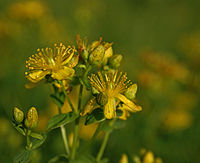| Hypericum |

|
| Hypericum perforatum,
the type species of the genus |

|
| Hypericum calycinum,
an ornamental plant of the genus |
| Clades[1] |
|
The genus Hypericum contains approximately 500 species which are divided into 36 sections as described by botanist Norman Robson.[2] This division into distinct sections is largely due to the fact that a genus-wide monograph was performed by Robson in 1977, which allowed for a comprehensive analysis of the genus's taxonomy.[3] A phylogenetic study was more recently completed for the genus, which gave evidence to suggest that the genus Triadenum is a clade within Hypericum and that the genus Thornea is sister to Hypericum. In addition, the study found that about 60% of the sections of Hypericum are monophyletic.[4]
Almost all species of Hypericum are either perennial herbs, shrubs, or small trees, but the genus also contains a small amount of subshrubs and annual herbs.[3] Most of its species contain hypericin or hyperforin and some are used for their healing properties in folk medicine. The species' leaves are always placed opposite, and are normally decussate.[5] Their flowers are generally homostylous, but very few are dimorphically heterostylous. The petals are normally golden yellow or orange, but some are white or cream, and are veined dorsally. They have 4-5 stamen fascicles, 2-5 ovaries, and 2-5 styles. Some species grow capsular fruit which are colored red or blackish.[6]
Hypericum species can be found all over the world in temperate to tropical areas. The genus is most diverse in Turkey (~80 species) and China (~60 species), but can be found across Asia and Europe, in parts of Africa and South America, Australia, and across the United States and southern Canada.[7] Non-native species have also been introduced into various regions of the United States and Argentina.[8] The genus are generally found in dry, desert areas to being in shallow water, and can be found from warm temperate climates to cold temperate climates.[6]
Some Hypericum species are used as ornamental plants because of their large, spreading flowers.[9] These include H. aegypticum, H. androsaemum, H. calycinum, and H. olympicum. In addition, there are a number of hybrids and cultivars that have been developed for use in horticulture. Some notable cultivars are H. × moserianum, H. 'Hidcote', and H. 'Rowallane'. Several species are also used for their medicinal properties, especially their ability to alleviate mild clinical depression, by drawing out the oily extract from the flowers.[10] H. perforatum is the most potent out of all the species, and is the only species cultivated commercially for herbalism and medicine.[11]
- ^ Cite error: The named reference
Nurk 2010was invoked but never defined (see the help page). - ^ Cite error: The named reference
TPLwas invoked but never defined (see the help page). - ^ a b Cite error: The named reference
Robson 1977was invoked but never defined (see the help page). - ^ Cite error: The named reference
Nurk 2013was invoked but never defined (see the help page). - ^ Cite error: The named reference
Aqua Plantswas invoked but never defined (see the help page). - ^ a b Cite error: The named reference
Hypericum MySpecieswas invoked but never defined (see the help page). - ^ Cite error: The named reference
:77was invoked but never defined (see the help page). - ^ Cite error: The named reference
POWOwas invoked but never defined (see the help page). - ^ Cite error: The named reference
A-Z RHSwas invoked but never defined (see the help page). - ^ Cite error: The named reference
Szegedi 2005was invoked but never defined (see the help page). - ^ Cite error: The named reference
Klemow 2011was invoked but never defined (see the help page).